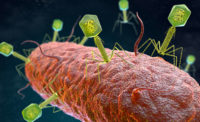Battling Salmonella
By Peter J. Taormina, Ph.D
At a time when the public is realizing that Salmonella can crop up in the strangest places (e.g. fruits and vegetables, peanut butter, and chocolate), the meat and poultry industry is re-focusing efforts against this familiar foe.
Recalls and major outbreaks from contaminated food products not normally thought of as vehicles of salmonellosis have demonstrated that these bacteria can survive in and adapt to diverse environments. Additionally, the emergence and spread of multi-drug resistant Salmonella in the environment and in food-producing animals continues to be a major challenge to the industry. Certain serovars of Salmonella species possess genes that enable the pathogen to resist antibiotics commonly used in humans and animals, thereby rendering some antibiotic treatments less effective.
Collectively, the industry has approached the fight against Salmonella by funding numerous studies at public universities and other research institutes to investigate detection, control, and elimination along the chain from farm to fork. The information that is generated helps the industry focus its efforts and design optimal intervention strategies directed at husbandry, transportation practices, slaughter, and further processing. The meat industry also routinely sponsors meetings to focus on food safety challenges, including Salmonella. Individual companies operate food safety management programs that include assays for Salmonella in the battery of routine analyses.
Testing is usually intended to verify that interventions are working or to catch the pathogen before it enters a plant or process. Samples types might include raw meat, carcass sponge samples, whole bird rinses, and eggs. Testing is also performed to verify the effectiveness of a new process or to address process deviations in thermally treated products.
Many laboratorians continue to rely on conventional techniques which incorporate selective and differential agar media for identification of Salmonella following enrichment of samples. Various, so-called, “rapid methods” have been employed to decrease the time of analysis following the sample enrichment period. Biochemical, serological, and nucleic acid-based techniques such as PCR are used to quickly identify Salmonella and reduce the time to release lots of raw product.
Some effort has been directed at reducing the standard 48-hours of enrichment by developing more sensitive detection assays. Researchers in Denmark recently published work demonstrating a 12-hour enrichment-PCR method for Salmonella detection from pork meat and poultry samples that also produced results comparable to a lengthy reference culture method (see Jesefsen et al., 2007. Appl. Environ. Microbiol. 73:3040). In any case, methods that have received formal recognition through associations like AOAC International provide the best choice for reliable and defensible results. More information on methodology for detection of Salmonella spp. can be found in the USDA-FSIS Microbiology Laboratory Guidebook.
To date Salmonella has shown a remarkable tolerance to acid, heat, and drying that enable its survival and transmission through a variety of commodities. Those salmonellae that possess the genes for resistance to multiple antibiotics may increase the severity of infections and magnitude of outbreaks. Clearly, new and innovative intervention strategies are needed in order to stay ahead of this versatile pathogen.
Peter J. Taormina, Ph.D. is Assistant Professor at the Center for Food Safety, University of Georgia. Previously Dr. Taormina held positions as a research microbiologist at John Morrell and Co. and The Coca-Cola Company. (ph: 770-467-6066 taormina@uga.edu www.ugacfs.org)


Report Abusive Comment